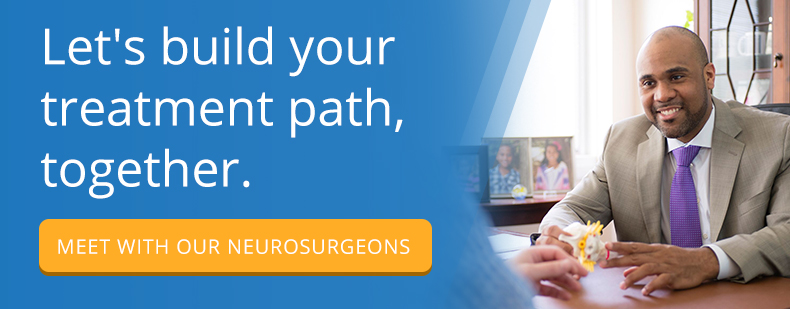When you have an upcoming Chiari decompression surgery, it is just as important to prepare yourself mentally as it is physically. Becoming an informed patient is an important part of the process, ensuring that you learn as much as you can about your condition and procedure. Through self-education, you can better understand important aspects of your overall health, surgery risks and specific details about Chiari decompression. Armed with this information, you can feel confident about entrusting your health to a surgeon, knowing that the benefits outweigh the potential risks.
Understanding Why You Require Surgery
To understand what Chiari decompression surgery entails, it is important to know about the condition itself. As you grow, your brain and skull develop together. This usually results in a perfect fit of the spaces and grooves within the skull to hold the differently-shaped areas of the brain.
However, sometimes there is a mismatch between the space within the skull, and the cerebellum an area of the brain near the base of the skull, pushes down through the foramen magnum, an opening where the spinal cord and blood vessels pass through the bottom of the skull. This can cause buildup of cerebrospinal fluid (CSF), the fluid that bathes the brain and spinal cord or direct compression on the brainstem or spinal cord.
Understanding Your Chiari Decompression Surgery
Your surgeon has recommended the treatment that he or she feels is right for you. It could be a more traditional treatment, which uses standard surgical tools and procedures. These include dural opening Chiari decompression, cervical laminectomy and CSF diversion.
Because of technological advances, there are also minimally invasive Chiari decompression surgery options, which include minimally invasive Chiari decompression surgery and non-dural opening posterior fossa decompression. These approaches utilize specialized tools and microscopic visualization – hence, the “minimally invasive” label.
Dural Opening Chiari Decompression
During a dural opening Chiari decompression procedure, the surgeon removes a section of bone from the back of the skull, as well as part of the dura, the membrane that covers the brain. The surgeon then places a patch made out of synthetic or natural materials, creating more space for the cerebellum and helping alleviate the pressure caused by compression.
Patients who undergo traditional Chiari decompression surgery can expect to spend up to a week in the hospital following the procedure, as well as approximately six weeks of activity restrictions at home.
Cervical Laminectomy
Cervical laminectomy is a procedure that may be performed alone or in conjunction with Chiari decompression surgery. The surgeon removes a small section of the uppermost vertebrae, the lamina, which helps create more space within the spinal canal. This is another method of alleviating pressure and preventing further damage to the spinal cord.
CSF Diversion
CSF diversion may be necessary for patients who have a backup of cerebrospinal fluid (CSF) that needs to be removed to help relieve pressure and symptoms. The surgeon can place a shunt to divert the fluid from the area of buildup to another location within the body, such as the abdomen, where it can be reabsorbed by the body’s natural physiological processes.
Minimally Invasive Chiari Decompression Surgery
Minimally invasive Chiari decompression surgery achieves the same results as traditional decompression surgery but with a smaller incision, less bleeding, and reduced pain and healing time for patients. The opening in the dura is much smaller, removing the need for a patch graft, and overall surgery time is typically shorter, making this an excellent treatment choice for many patients.
Non-dural Opening Posterior Fossa Decompression Surgery
Non-dural opening posterior fossa decompression surgery is another minimally invasive approach that avoids creating an opening in the dura at all, also eliminating the need for a patch graft. Instead, the surgeon uses specialized instruments to remove a small section at the base of the skull, making room within the posterior fossa for the cerebellum. Again, because there is less disruption to surrounding tissues, pain and healing times are typically less than with traditional surgical approaches.
Understanding Potential Risks of Any Surgery
Any time a person undergoes a surgical procedure, there are risks that a surgeon takes into consideration. Although the overall risk may be low, knowing the potential risks is important when making a decision in regards to surgery.
While some risks are specific to Chiari decompression surgery, there are other risks that are more general. Some of the general risks of any surgical procedure include:
- Bleeding
- Infection
- Blood clots
- Stroke
- Anesthesia risks
Your surgeon will take precautions before, during and after the surgery to minimize these potential complications. He or she will give you specific instructions about modifying your prescriptions, food and liquid intake, smoking cessation and other ways to reduce the risks during and after your surgery.
Understanding Risks Specific to Chiari Decompression Surgery
Along with the general risks related to surgery, there are potential complications specifically related to Chiari decompression surgery due to the nature and location of the procedure.
Cerebrospinal Fluid Leakage
One of the main risks is leakage of cerebrospinal fluid (CSF), the fluid which surrounds the brain and the spinal cord, providing a cushion and transporting nutrients. Leakage can happen if the dura, the membrane that covers the brain, is punctured and the repair is not watertight. The CSF leaks out from the defect in the dura and collects under the skin causing a pseudomeningocele.
A CSF leak can lead to a headache that feels better when you lie down, as well as nausea and light sensitivity. Oftentimes the leak will resolve on its own as long as it is confined to the space under the skin. Increasing your fluid intake will help. Your physician may recommend increased caffeine intake, as well as a period of bed rest. Sometimes the CSF, which is a clear, watery fluid, drains out of the ear, nose or incision which can cause an increased infection risk. In these cases, surgery to repair the leak may be necessary.
Hydrocephalus
The second major risk related to Chiari decompression surgery (and other brain surgeries) is a condition known as hydrocephalus, which is the buildup of CSF within the brain. This leads to an increase in pressure within the skull, and may even be a symptom you are already experiencing due to your Chiari malformation. Treatment involves draining the fluid from the brain, usually through the surgical implantation of a temporary or permanent shunt.
While both of these potential complications do happen, they are rare and treatable. The surgeon will inform you of possible symptoms, and you will be monitored in the hospital following the procedure for any signs of either condition.
Neck Pain and Headaches
Because of the nature of your procedure, you will likely experience head and neck pain during your recovery. These can be managed with medications and home exercises that improve strength and flexibility. These neck pains and headaches are typically related to the surgery itself and will be different from the symptoms you experience due to your Chiari malformation, which should be reduced following your surgery.
Nerve Damage or Brain Injury
Your Chiari malformation is in a very delicate area of your body, where there is the potential for temporary or permanent damage to the surrounding structures. However, your surgeon will do everything possible during your Chiari decompression surgery to avoid complications.
Every surgical procedure carries a certain degree of risk, but your doctor has weighed the potential risks against the benefits of surgery and only offer options where the risks are reasonably low.
Be Comfortable With Your Treatment
Before recommending any procedure, a surgeon must consider each individual patient and weigh the potential risks and benefits of all possible treatments. Your physician knows you and your specific condition, and he or she has recommended Chiari decompression surgery for you because he or she believes, as your healthcare provider, that it is in your best interest. Knowing the potential risks and benefits allows you, the patient, to make an informed decision regarding surgery.
If you still have questions or any apprehension, be sure to discuss it with your physician or surgeon prior to your day of surgery. They want to ensure your comfort before, during and after your procedure.


